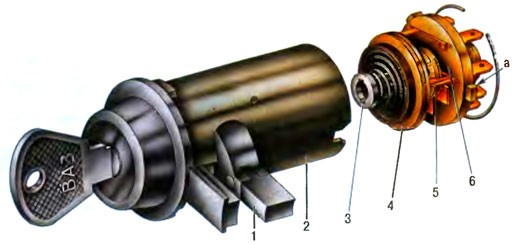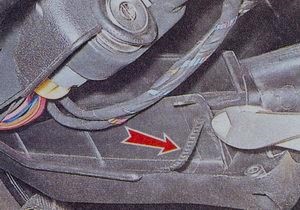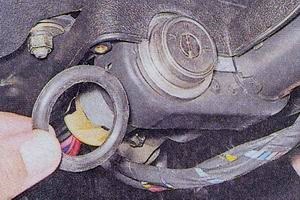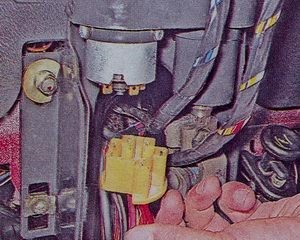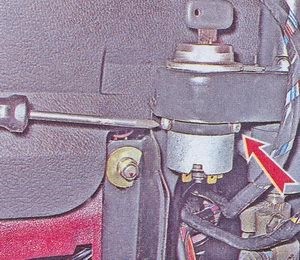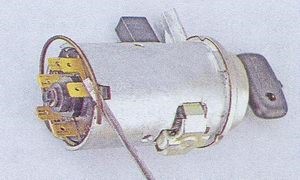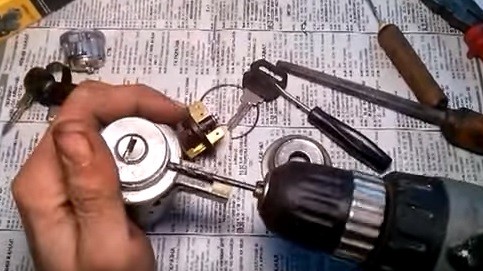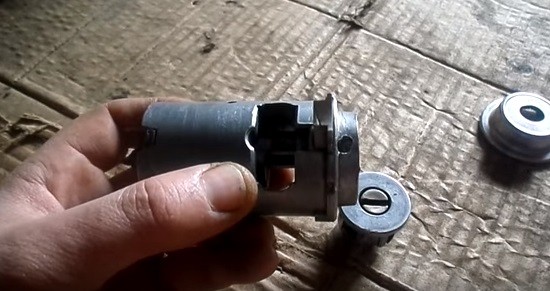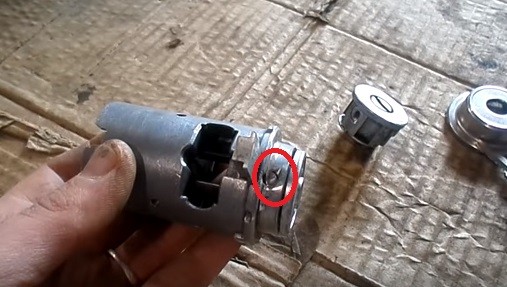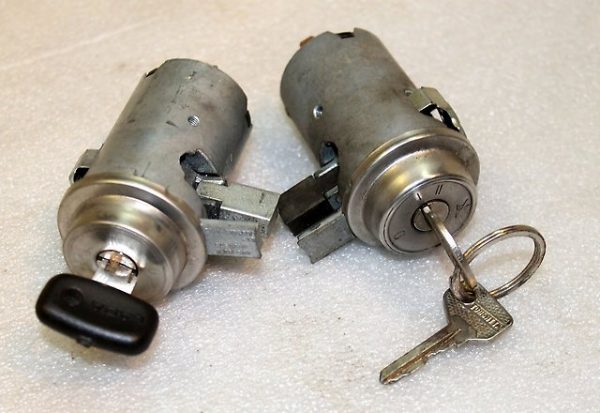
Design features and self-repair of the ignition lock VAZ 2101
Content
Although the ignition switch is not the main element of the system, its failure can cause a lot of trouble. In this article, we will try to understand the design features of the VAZ 2101 ignition switch, and also consider its most common malfunctions and methods for their elimination.
Ignition lock VAZ 2101
Not every driver, turning the ignition key in the lock, imagines how this same lock starts the engine. For most car owners, this habitual action, performed several times a day, does not raise any questions or associations. But when the castle suddenly refuses to work normally, there comes a moment of despair.
But not everything is so sad, especially if we are dealing with a “penny”, where absolutely all nodes and mechanisms are so simple that even a beginner can repair any of them.

The purpose of the ignition lock VAZ 2101
The ignition lock is not only for starting the engine. In fact, it performs several functions at once:
- supplies voltage to the vehicle's on-board network, closing the circuits of the ignition system, lighting, sound alarm, additional devices and instruments;
- at the command of the driver, turns on the starter to start the power plant and turns it off;
- cuts off power to the on-board circuit, keeping the battery charge;
- protects the car from theft by fixing the steering shaft.
Location of the ignition lock VAZ 2101
In "kopeks", as in all other models of "Zhiguli", the ignition switch is located to the left of the steering column. It is fixed directly to it with two fixing bolts. The entire mechanism of the device, except for the upper part, in which the keyhole is located, is hidden from our eyes with a plastic casing.
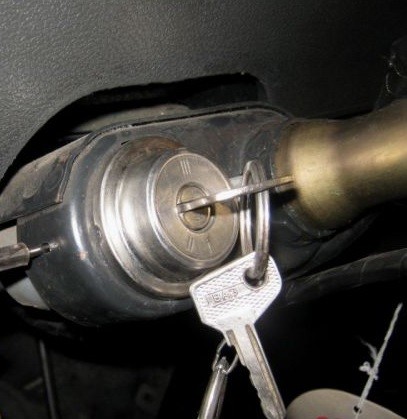
The meaning of labels
On the visible part of the ignition lock case, special marks are applied in a certain order, allowing inexperienced drivers to navigate in the lock activation mode when the key is in the well:
- "0" - a label indicating that all systems, devices and devices that are switched on with the lock are turned off (these do not include the cigarette lighter, the interior lighting dome, the brake light, and in some cases the radio tape recorder);
- "I" is a label informing that the vehicle's on-board network is powered by the battery. In this position, the key is fixed independently, and electricity is supplied to the ignition system, to the electric motors of the heater and windshield washer, instrumentation, headlights and light alarms;
- "II" - engine start mark. It indicates that voltage is applied to the starter. The key is not fixed in this position. If released, it will return to the "I" position. This is done in order not to expose the starter to unnecessary stress;
- "III" - parking mark. If the key is removed from the ignition in this position, the steering column is locked with a latch. It can be unlocked only by inserting the key back and moving it to the "0" or "I" position.
It is important to note that not all labels are located one after the other: the first three of them go clockwise, and "III" is before "0".
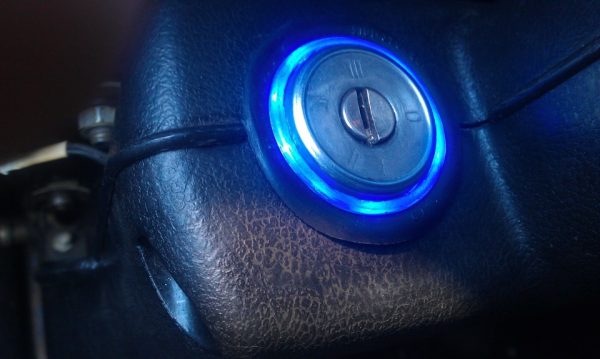
Pinout of the conclusions of the ignition lock VAZ 2101
The “penny” ignition lock has five contacts and, accordingly, five conclusions, which are responsible for supplying voltage to the desired node. All of them are numbered for convenience. Each pin corresponds to a wire of a certain color:
- "50" - the output responsible for supplying current to the starter (red or purple wire);
- "15" - a terminal through which voltage is supplied to the ignition system, to the electric motors of the heater, washer, dashboard (blue double wire with a black stripe);
- "30" and "30/1" - constant "plus" (wires are pink and brown, respectively);
- "INT" - outdoor lighting and light signaling (double black wire).
 A wire of a certain color is connected to each of the conclusions.
A wire of a certain color is connected to each of the conclusions.
The design of the ignition lock VAZ 2101
The "penny" ignition lock consists of three parts:
- the actual castle (larvae);
- steering rack locking mechanism;
- contact groups.
 1 - locking rod; 2 - body; 3 - roller; 4 - contact disk; 5 - contact sleeve; 6 - contact block; a - a wide protrusion of the contact block
1 - locking rod; 2 - body; 3 - roller; 4 - contact disk; 5 - contact sleeve; 6 - contact block; a - a wide protrusion of the contact block
Larva
The lock cylinder (cylinder) is the mechanism that identifies the ignition key. Its design is about the same as that of conventional door locks, only a little simpler. When we insert the "native" key into the well, its teeth set the pins of the lock to a position in which it freely rotates with the cylinder. If you insert another key, the pins will not fall into place, and the larva will remain motionless.
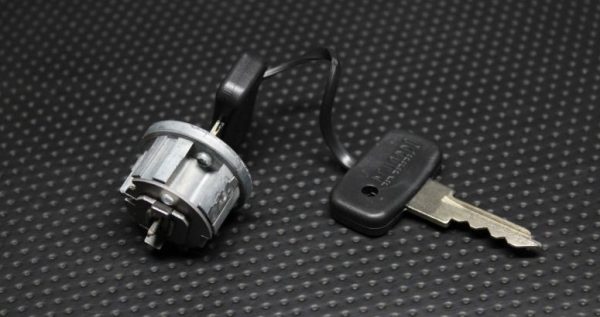
Steering rack locking mechanism
The ignition locks of almost all cars are equipped with an anti-theft mechanism of this kind. The principle of its operation is quite simple. When we remove the key from the lock, the cylinder of which is in the corresponding position, a locking rod made of steel is extended from the cylinder under the action of a spring. It enters a specially provided recess in the steering shaft, fixing it. If a stranger somehow even starts the car engine, he is unlikely to be able to go far on it.
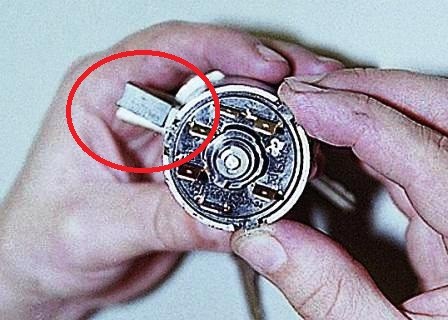
contact Group
A group of contacts is a kind of electrical switch. With its help, turning the key in the ignition, we simply close the electrical circuits we need. The design of the group is based on a block with contacts and leads for connecting the corresponding wires, as well as a contact disk with a contact powered from the positive terminal of the battery. When the larva rotates, the disk also rotates, closing or opening a certain circuit.
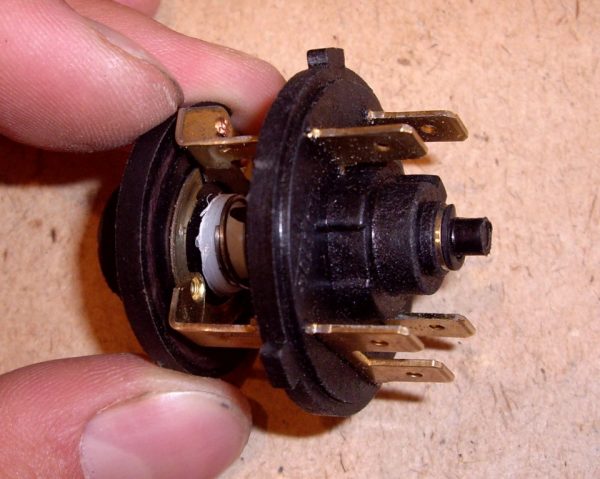
Malfunctions of the ignition lock VAZ 2101 and their symptoms
The ignition lock may fail due to the breakdown of one of the constituent parts of its design. These faults include:
- breakage of the larva (wear of the pins, weakening of their springs, wear of the pin seats);
- wear, mechanical damage to the locking rod or its spring;
- oxidation, burning, wear or mechanical damage to contacts, contact leads.
Damage of the larva
A sign that it was the larva that broke down is the inability to insert the key into the ignition hole, or turn it to the desired position. Sometimes the cylinder fails when the key is inserted into it. Then, on the contrary, there are difficulties with its extraction. In such cases, you should not use force, trying to restore the lock to working capacity. So you can break the key, and instead of replacing one part of the device, you have to change the lock assembly.
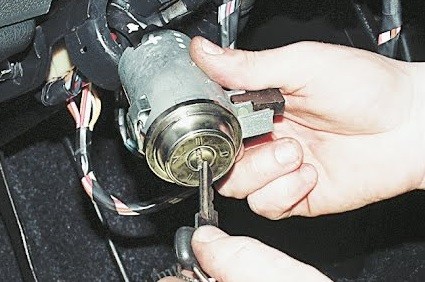
Locking rod failure
The lock rod itself is difficult to break, but if you apply enough force and pull the steering wheel while the shaft is locked, it can break. And not the fact that in this case the steering shaft will begin to rotate freely. So if the lock breaks when the steering wheel is fixed, in no case should you try to resolve the issue by force. It is better to spend a little time, disassemble it and fix it.
It may also happen that due to the wear of the rod or the weakening of its spring, the steering shaft will no longer be fixed in position "III". Such a breakdown is not critical, except that it will become a little easier to steal a car.
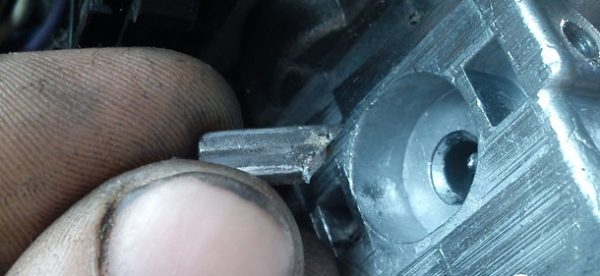
Contact group malfunction
Problems with a group of contacts are quite common. Usually, the cause of its malfunction is burning, oxidation or wear of the contacts themselves, as well as their conclusions, to which the wires are attached. Signs that the contact group is out of order are:
- no signs of operation of instrumentation, lighting lamps, light signaling, heater fan motors and windshield washer when the key is in the "I" position;
- lack of starter response when the key is moved to position "II";
- constant voltage supply to the vehicle's on-board network, regardless of the key position (ignition does not turn off).
There are two ways to deal with such malfunctions: repairing the contact group, or replacing it. In the event that the contacts are simply oxidized or slightly burnt, they can be cleaned, after which the lock will work again in normal mode. If they are completely burnt out, or worn out so that they cannot perform their functions, the contact group must be replaced.

Repair of the ignition lock VAZ 2101
In any case, in order to understand the exact cause of the breakdown of the ignition switch, as well as to decide whether it is worth repairing it or replacing it immediately, the device must be dismantled and disassembled. We will talk about this further.
Removing the ignition lock VAZ 2101
To dismantle the lock, we need the following tools:
- a wrench on 10;
- Phillips screwdriver (preferably a short one)
- small slotted screwdriver;
- nippers or scissors;
- awl.
The order of work is as follows:
- We put the car on a flat area, turn on the gear.
- Using a 10 key, unscrew and disconnect the "-" terminal from the battery.
- Let's go to the salon. Using a Phillips screwdriver, remove the four screws securing the two halves of the steering column cover.
- With the same tool, we unscrew the self-tapping screw fixing the casing to the steering column switch
- We remove the button of the light alarm switch from the seat.
 The casing consists of two halves connected by screws. A - self-tapping screw, B - alarm button
The casing consists of two halves connected by screws. A - self-tapping screw, B - alarm button - We remove the lower half of the casing and cut the plastic wire clamp with wire cutters or scissors.
 Clamp need to have a bite to eat with wire cutters
Clamp need to have a bite to eat with wire cutters - Remove the lower half of the casing.
- Use a thin slotted screwdriver to pry off the sealing ring of the ignition switch. We remove the seal.
 To remove the ring, you need to pry it with a screwdriver
To remove the ring, you need to pry it with a screwdriver - Disconnect the upper half of the steering casing.
- Hand carefully disconnect the connector with wires from the ignition switch.
 Connector can be easily removed by hand
Connector can be easily removed by hand - We insert the ignition key into the well
- We set the key to position "0", shaking the steering wheel so that it unlocks.
- Using a Phillips screwdriver, unscrew the two screws securing the lock to the bracket on the steering shaft.
 The lock is attached to the bracket with two screws.
The lock is attached to the bracket with two screws. - Using an awl, we sink the locking rod through the side hole in the bracket.
 To remove the lock from the bracket, you need to drown the locking rod inside the case with an awl
To remove the lock from the bracket, you need to drown the locking rod inside the case with an awl - Remove the ignition lock from the bracket.
Dismantling the castle
To disassemble the ignition switch, you only need a thin slotted screwdriver. The order of disassembly is as follows:
- Using a screwdriver, pry off the retaining ring located in the groove of the device body.
- We take off the ring.
 To remove the contact group, you need to remove the retaining ring
To remove the contact group, you need to remove the retaining ring - We take out the contact group from the lock body.
We will talk about how to remove the larva a little later.
When is a repair worth it?
After disassembling the lock, it is worth carefully inspecting the well, the locking mechanism, and the contacts. Depending on the signs of a device malfunction, special attention should be paid to the node to which it belongs. If the key in the ignition did not turn due to a breakdown of the larva, you are unlikely to be able to repair it. But it can be replaced. Luckily, they are on sale and are inexpensive.
If the cause of the lock malfunction is wear or oxidation of the contacts, you can try to restore them using special anti-corrosion agents such as WD-40 and a dry coarse rag. For these purposes, it is undesirable to use abrasives, since deep scratches on the contact surfaces will provoke their further burning. In case of critical damage to the contacts, you can buy the contact group itself.
But, if the locking rod breaks, you will have to buy a complete lock, since one case is not for sale. The lock is replaced in the reverse order given in the instructions for its removal.
Table: approximate price for an ignition switch, a larva and a contact group for a VAZ 21201
| the name of detail | Catalogue number | Approximate price, rub. |
| Ignition switch assembly | 2101 – 3704000 Feet | 500 – 700 Feet |
| Ignition cylinder | 2101 – 6100045 Feet | 50 – 100 Feet |
| contact Group | 2101 – 3704100 Feet | 100 – 180 Feet |
Contact group replacement
To replace the VAZ 2101 ignition lock contact group, no tools are needed. It is enough to insert it into the case of the disassembled device, comparing the dimensions of the cutouts on the case and the protrusions on the contact part. After that, it is necessary to fix it with a retaining ring by installing it in the groove.
Larva replacement
But with the larva you have to tinker a little. Of the tools here are useful:
- electric drill with a drill with a diameter of 0,8–1 mm;
- a pin of the same diameter, 8–10 mm long;
- awl;
- thin slotted screwdriver;
- liquid type WD-40;
- small hammer.
The order of work is as follows:
- Using a slotted screwdriver, pry off the cover of the larva from below and remove it.
 To remove the cover, you need to pry it with a screwdriver.
To remove the cover, you need to pry it with a screwdriver. - We find a pin on the lock body that fixes the larva.
- We drill the pin with an electric drill, trying not to damage the lock body.
 The pin can only be drilled
The pin can only be drilled - With the help of an awl, we remove the remains of the pin from the hole.
 After the pin is drilled, the larva can be removed
After the pin is drilled, the larva can be removed - We take out the larva from the body.
- We process the working parts of the new larva with WD-40 liquid.
- We install a new larva in the body.
- We fix it with a new pin.
- We embed the pin completely with a small hammer.
 Instead of the old steel pin, it is better to install a new aluminum one.
Instead of the old steel pin, it is better to install a new aluminum one. - Install the cover in place.
Video: replacing the contact group and ignition lock cylinder VAZ 2101
Installing the "Start" button
Some owners of "penny" tune the ignition system of their cars by installing the "Start" button instead of the regular ignition switch. But what gives such tuning?
The essence of such alterations is to simplify the process of starting the engine. With a button instead of a lock, the driver does not have to poke the key into the lock, trying to get into the larva, especially without habit and without lighting. In addition, you do not need to carry the ignition key with you and worry that it will be lost. But this is not the main thing. The main thing is the opportunity to enjoy the process of starting the engine at the touch of a button, and also surprise the passenger with it.
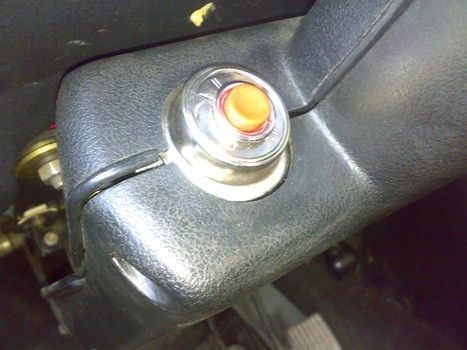

In automotive stores, you can purchase a kit for starting the power unit from the button for about 1500–2000 rubles.
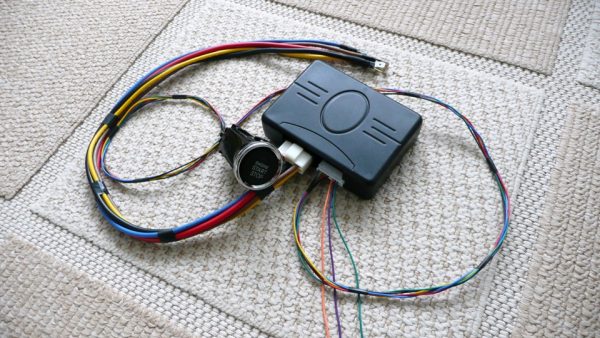

But you can not spend money, but assemble an analogue yourself. To do this, you only need a two-position toggle switch and a button (not recessed), which will fit the size of the ignition lock housing. The simplest connection diagram is shown in the figure.
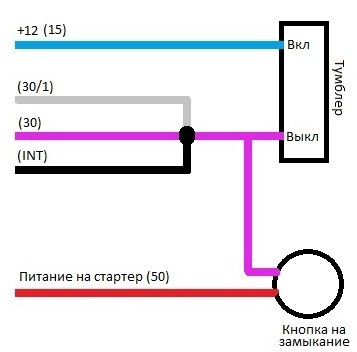

Thus, by turning on the toggle switch, we apply voltage to all devices and to the ignition system. By pressing the button, we start the starter. The toggle switch and the button itself, in principle, can be placed anywhere, as long as it is convenient.
As you can see, there is nothing complicated either in the design of the VAZ 2101 ignition switch or in its repair. In the event of a breakdown, you can easily repair or replace it.



